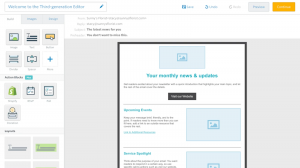There’s no such thing as a perfect email subject line. No one can give you a formula that will work every time.
However, you can follow these principles, which will guide you closer to writing email subject lines that are perfect for your audience.
It’s an iterative process though, so you’ll need to put in the work to reap the rewards.
1. Test your subject lines and measure the right metric.
Let’s get this one out of the way early. If you’re sending emails, you should be testing your subject lines.
Think of your email list as a living, breathing thing. It’s always changing. People come, people go, your content direction changes and attracts different people, etc. The email list you had 6 months ago is not the same email list you have now.
So, you need to be constantly testing subject lines because every insight you gain has a shelf life. What was once your top performing formula could be useless in a matter of weeks, depending on your growth.
Amelia Showalter of Pantheon Analytics, who led digital analytics for Obama’s 2012 campaign, agrees…
 Amelia Showalter, Pantheon Analytics:
Amelia Showalter, Pantheon Analytics:
“Eventually the novelty wore off, and we had to go back and retest.” (via Bloomberg)
When testing email subject lines, start by deciding what you want to learn. Sounds obvious, but many people run subject line A/B tests simply because the option is right there in their tool.
Once you know what you want to learn, you can design a meaningful hypothesis. From there, follow the same A/B testing processes and methodologies you’ve been reading about on CXL for years.
Generally, you’ll want to start by testing to variations on a small portion of your audience. Then, you can roll the winner out to the rest of your list and record the insights gained in an archive.
Here’s an example from the 2012 Obama campaign…
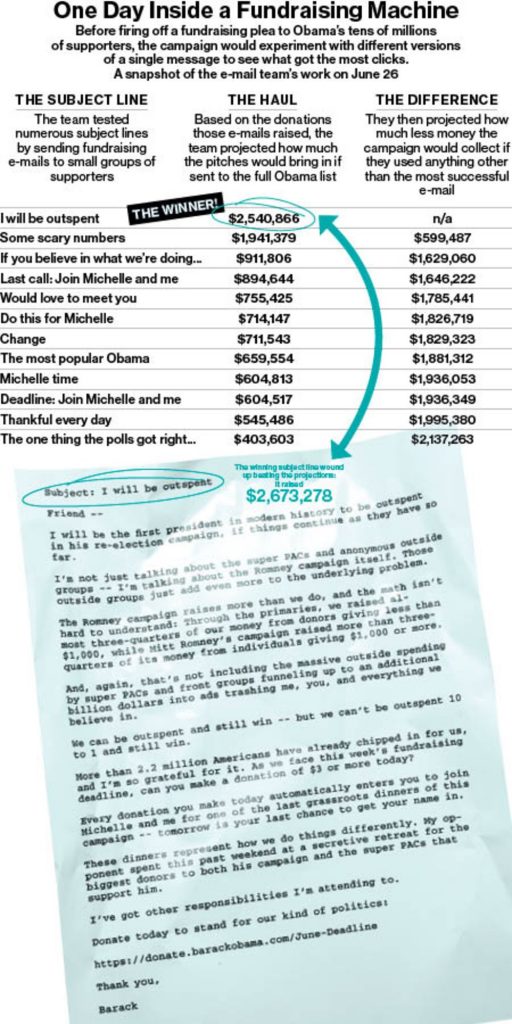
What works for email subject lines can and will shock you. Your preconceived ideas of what works and what doesn’t will be proven wrong. So, forget about best practices you’ve read in blog posts, pitch your craziest ideas and test everything…
 Amelia Showalter, Pantheon Analytics:
Amelia Showalter, Pantheon Analytics:
“We were so bad at predicting what would win that it only reinforced the need to constantly keep testing. Every time something really ugly won, it would shock me.” (via Bloomberg)
Of course, you’ll also want to be sure you’re focused on the right metric. As Joanna Wiebe from Copy Hackers and Airstory explains, open rate is the KPI for email subject lines…
 Joanna Wiebe, Copy Hackers & Airstory:
Joanna Wiebe, Copy Hackers & Airstory:
“If we tried to make subject lines also responsible for click throughs in our emails, then that would be really problematic. You know that a subject line is there to get people to open, and when used in combination with the from name, the purpose is to get people to open the email.
If you try to measure it based on whether people clicked through or purchased, I think you’d be setting that poor little subject line up for failure.” (via Litmus)
A good open rate is an open rate that has improved from the previous. But looking at averages can help guide you, so here’s a look at open rates by country…
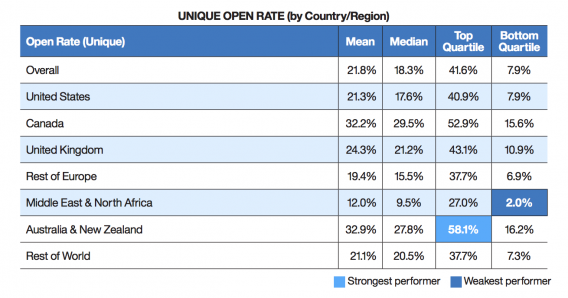
As well as open rates by industry…

As you can see, though, these numbers vary depending on the source…

So, the best average to judge your success by is your own.
Here’s a look at email open rates in each industry by device type…

Now take a look at that same data year over year…
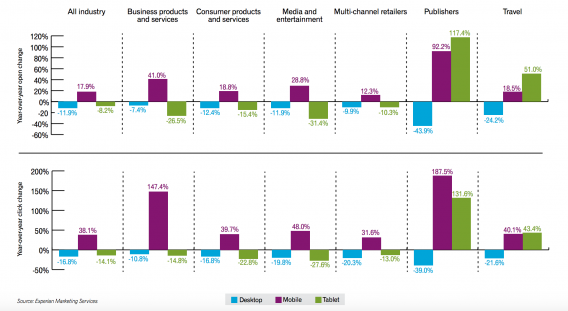
You can draw two conclusions from this…
- Without exception, mobile email use is on the rise.
- The industry average data is varied and purely based on a select sample, so the best place to look is and always will be within your own data.
A big problem email marketers encounter is inconclusive tests…

Inconclusive tests happen… often. But there are a few things you can do to minimize the neutral result. First, make sure you’re truly isolating and testing a single variable. As Loren McDonald of IBM Watson Marketing explains, it’s easy to get off track…
 Loren McDonald, IBM Watson Marketing:
Loren McDonald, IBM Watson Marketing:
“A) 1 in 5 emails will be opened on mobile | 5 key CRM questions
B) 1 in 5 emails will be opened on mobile
C) 5 key CRM questions
D) 5 key CRM questions | 1 in 5 emails will be opened on mobile
An A-B-C-D test approach like this would have accounted for any bias in the order of the content and the type of content used. For example, if both A and D had the highest performance, and if the test were repeated multiple times with different content, then a multiple topic subject line could be considered the winner.” (via Silverpop)
Second, it’s likely you’ll have to run tests multiple times to confirm the results. There are a lot of external factors that play into email, increasing the risk of sample pollution.
2. Research your audience’s voice.
If you haven’t already, take the time to research your audience’s voice. This can be time-consuming, but the insights can be used for all of your other copywriting efforts, so it’s worth it.
Here’s a basic process you can follow to get to the heart of your audience’s voice…
- Run customer and lead surveys. Focus on open-ended questions that’ll give you insight into: who they are, what words and phrases they use, and how they really feel about your brand / product.
- Schedule 1-on-1 customer interviews. I’ve written an entire article on this topic, so I won’t go into too much detail here, but talking face to face (even over Skype) gives you much deeper insights.
- Analyze the qualitative data and identify trends / patterns. It helps to code your data: needs / wants, pain points / benefits, hesitations, likes / preferences, etc. Then, consolidate your data and show the frequency at which each was mentioned. What trends / patterns do you see?
I really recommend reading this voice of customer article Jen Havice wrote for CXL.
Once you’ve done the research, rely on it. Go back to it for every email subject line you write. More importantly, conduct the research regularly to ensure it’s up to date. (Your customers change, after all.)
You can also use other insights you may already know. For example, what types of value propositions work best, what words get your audience clicking on your PPC ads, etc.
When thinking about words that get your audience clicking, you might be tempted to turn to Google, which would return something like this…

Please resist that temptation. Focus on the data you have (or could easily have) in front of you.
3. Use personalization… strategically.
I’ve written an entire article on email personalization, so I’ll keep this short to avoid rehashing what’s already been said.
Personalization comes in many forms…
- Including a first name in the subject line.
- Including a location reference in the subject line.
- Including a birthday or other significant date in the subject line.
- Including purchase or activity information in the subject line.
All these forms help reinforce one simple concept: this email was written just for you.
Chris Hexton of Vero offers some additional personalization ideas you can test for yourself…
 Chris Hexton, Vero:
Chris Hexton, Vero:
“When personalising your subject line, here are a few things you can A/B test:
- First and last name: it might be common but it’s always worth a try!
- Alter the details in the subject line based on the recipient’s location: summer vs. winter and holidays in different parts of the world (Father’s Day isn’t the same date in every country) are two examples.
- Gender: using men vs. women in the subject line of a clothing store’s newsletter or highlighting specific product names for each group are some basic examples.
- Use details of the actions the customer has taken: what has the customer been doing on your website? What are their favourite products or what features are they yet to use? The examples above all use this tip.” (via Unbounce)
Is there any data to support the idea that personalization works and isn’t just the latest trend? Yes, actually…
- MailerMailer found that personalized subject lines had an average open rate of 12.9%, compared to 9.8% for subject lines without personalization.
- Experian found that personalized subject lines had 26% higher open rates than subject lines without personalization. The lift was highest for travel companies.
MailChimp also conducted some research into personalization performance. They found that first and last name have the biggest impact on open rate…

And that first name personalization works better in some industries than others (and not at all in the legal industry)…

Again, personalization is something you want to test. Please don’t take this research’s word for it.
What’s interesting is that despite these overwhelmingly positive results, the Experian study found that 70% of brands don’t personalize their emails at all.
Now, that might be because companies just don’t know enough about their email leads or even customers to really take advantage of email subject line personalization.
One solution is implementing a one-click onboarding survey like this…
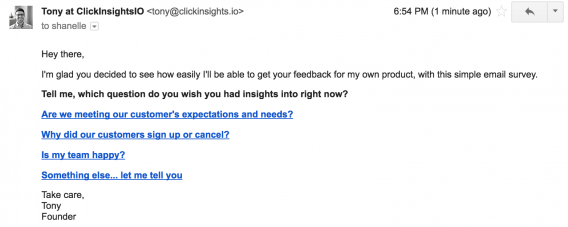
Or you can try a more extensive survey, like the one we use for CXL…
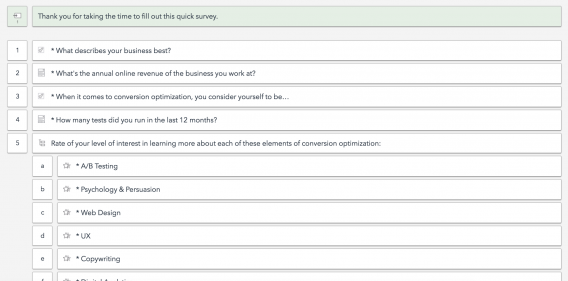
Then, you can personalization email subject lines based on the data you collect.
Using personalization too much or using it incorrectly (e.g. “Hello |FNAME|”) really sucks. So don’t use personalization unless it’s adding value to your recipients.
4. Be specific, descriptive and clear.
Being trendy or clever is often worse than being clear and direct. If you’re familiar with heuristic analysis, you know that clarity is a key factor of optimization. (You can read more about improving clarity, in general, in this article.)
For example…
- In 2014, 2,211 MailChimp campaigns had “dads and grads” in the subject line.
- Half way through 2015, MailChimp users had already sent 2,005 “dads and grads” emails.
Those “dads and grads” emails, sent around Father’s Day / graduation season, had an average open rate of 18%. Not too bad, but lower than MailChimp’s benchmark.
Kate Kiefer Lee, Communications Director, explains…
 Kate Kiefer Lee, MailChimp:
Kate Kiefer Lee, MailChimp:
“If you’re thinking of sending a campaign with a trendy subject line like ‘Gifts for Dads and Grads’ (or one that references ‘sizzling’ summertime deals, which I imagine is coming to my inbox soon), I won’t stop you.
But I will encourage you to test it against one that’s a little more straightforward. Try something like: ‘Our annual apparel sale starts now.’ Not every customer enjoys a marketing slogan.
Plus, if the straightforward subject line wins, you can always get creative with your headlines in the body of the email. Or you can try a happy medium: a descriptive subject line with personality.” (via MailChimp)
Also note how the trend started in 2014 and seemingly picked up in 2015. Hey, maybe the first 100-200 companies that sent a “dads and grads” email saw a huge return because it was new and original. But by the 4,000th company, I’m sure the concept was stale.
That’s the problem with doing something because it’s trendy. By the time you hear about it, it’s probably already overdone.
MailChimp conducted another interesting study. This time, they analyzed over 40M emails and singled out the ones with the highest and lowest open rates. The highest open rates were in the 60-87% range while the lowest open rates were in the 1-14% range.

Hopefully you notice the difference. On the best side, the email subject lines are straightforward and clear. On the worst side, they’re salesy.
Why? A big reason is likely that people get a lot of email spam, so they’re great at detecting it. If it reads like an unsolicited sales pitch, it’s probably being reported as spam before it gets deleted.
Note that being direct and clear does not mean being devoid of personality. Here’s an example from my own personal inbox…
![]()
And another…
![]()
In both cases, I can guess what will be inside the email, so clarity is high. Yet both have personality.
Here’s an exception and something you might want to test for yourself. Sometimes being vague builds suspense and piques interest. Here’s another example from my inbox…
![]()
It’s undoubtedly a vague and unclear subject line, right? Here’s the response…

Joanna calls this the curiosity gap or empty suitcase…
 Joanna Wiebe, Copy Hackers & Airstory:
Joanna Wiebe, Copy Hackers & Airstory:
“Then comes the ‘This is how you get traffic and convert it…’
This is the open loop, or curiosity gap, in that you’ve been introduced to this idea that there’s a way to do the thing that you really want to do. But importantly, the subject line doesn’t say what it is.
It says ‘this.’
In ‘writerly’ language, that’s called an empty suitcase. ‘This’ without a noun after it, is the empty suitcase.
I don’t know why they call it an empty suitcase [laughs]. I learned it all the way back in my first year as an English major. And it’s not like we sat around talking about grammar as English majors, but somehow I learned it and it’s been really valuable to know it.
It’s a bad practice when you’re writing an essay or a novel to have an empty suitcase. But it’s a very good thing for copywriting if you want people to be intrigued enough to click or open.” (via Litmus)
One thing matters most when considering whether to stick with clarity or experiment with an empty suitcase, a trend, a joke or pun, etc. Expectation.
Are your subscribers signed up specifically for promotions? Maybe those cheesy, salesy email subject lines will work. Test it. Are your subscribers signed up specifically for your newsletter? Maybe an empty suitcase will help you stand out. Test it.
5. Be aware of mobile subject line character restrictions.
Character counts mean next to nothing to your open rate.
MailChimp is one of the many companies to look into email subject line character counts. They pulled data on 12B emails sent and analyze the subject line length. The results?
Sometimes, people like long subject lines…

Sometimes, people like short subject lines…

John Foreman, VP of Product Management, explains…
 John Foreman, MailChimp:
John Foreman, MailChimp:
“Even if there existed a pretty graph showing a relationship between subject-line length and campaign performance, that doesn’t mean that by padding your subject with purple prose you’d suddenly be swimming in a sea of opens and clicks.
No, that relationship (like what is shown above for users X and Y) is likely caused by a third variable.
For instance, what if I sent out a weekly campaign with the subject line “Christmas sale on processed meat logs full of fat and salt” and didn’t get any opens, so I changed it to “Sale on summer sausage.” Well, “summer sausage” sounds a lot more appetizing than “meat log.”
I bet I’d get better performance. Would that be due to the lower character count? Only indirectly. Rather, it’s due to my astute change in diction. Hemingway would be proud.” (via MailChimp)
Most of the time, people don’t really give a damn…

Yesware found similar results in their own study of subject line length…

Here comes the but. But email subject line count does matter on mobile. Check out this email subject line on desktop…
![]()
And on mobile…

If you recall, mobile email open rates are increasing across the board. So, you want to be aware of how your subject line will appear (or, rather, not appear) on mobile. Simply find the top mobile email clients for your audience and then find the subject line character count restrictions for each.
That’s not to say you should never go beyond those restrictions. It’s just something you should be aware of.
6. Choose every word carefully.
In the testing world, a single word in a headline is inconsequential. In the email subject line world, those minute changes can have huge rewards.
Alexis Rodrigo of Mirasee explains how a single word can have a major impact on the open rate…
 Alexis Rodrigo, Mirasee:
Alexis Rodrigo, Mirasee:
“In 2013, Adestra released a study of email subject lines from 2.2 billion emails in an attempt to identify specific words and phrases that get both higher open rates and higher click rates.
The study covered various sectors, including B2B, B2C, nonprofit, retail and e-commerce.
Across all sectors, the email subject lines with the following words and phrases had open and click rates that were higher than average:
- Free delivery
- Sale
- Alert
- News
- Video
- Win
- Daily
- Weekly” (via Vero)
It makes sense when you really think about it. Email subject lines are short and vital to persuading a recipient to open. Each word plays a significant role.
MailChimp was able to confirm the significant impact of single words and short phrases in a study they conducted. Here’s a look a words that imply time sensitivity…

And commonly used word pairs…

And free vs. freebie…

And even something as seemingly unimportant as capitalization…

But, of course, all of this data is all contextual. Above, we saw a 0.02 impact on the open rate in standard deviations when using “free”. Below, you’ll see the word performs better and worse in some industries…

So, again, test this for yourself. As Neel Shivdasani, Data Scientist, explains, the real takeaway here is not which words you should use in your subject lines…
 Neel Shivdasani, MailChimp:
Neel Shivdasani, MailChimp:
“The more interesting takeaway, though, is that a single word’s presence can dramatically alter the likelihood that your readers will open your emails. The content of your message is really what determines which words you use, but with so few words in a subject line, each one matters quite a lot.” (via MailChimp)
Now, most email marketing tools have a subject line researching tool of some sort built right in that can help with word and phrase selection. Be aware that the data is typically pulled from all campaigns being sent via the tool, not just your data.
Here’s a look at how MailChimp does it. Just input some terms…

And it’ll spit back some suggestions…

Whatever email marketing tool you’re using, you likely have a feature like this built in already, so take a look around for it. If you want to be truly data-driven, use these types of tools (and your own audience research) as ideation assistants.
Test the suggestions you get, don’t accept them as absolutes.
7. Please, please segment your list.
I’ve written an entire article on email segmentation, so I’ll keep this short to avoid rehashing what’s already been said.
Segmentation works wonders. In fact, MailChimp has found that open rates are 14.31% higher when the email campaign is segmented…
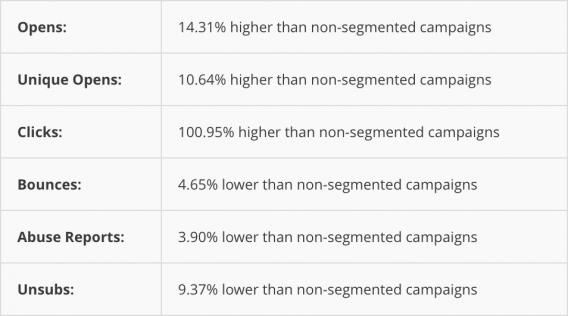
As with any type of segmentation, your options are virtually endless, but here are a few examples…
- Segment based on opt-in offer.
- Segment based on stage of the sales cycle.
- Segment based on activity.
- Segment based on industry.
- Segment based on location.
- Segment based on previous purchases.
Once you have set up your segments, you can test email subject lines within individual segments. For example, do people who opted into the beginner’s guide respond better to Variation X or Variation Y? Do people who work for agencies respond better to Variation A or Variation B?
Any time you can drill further down and extract more segmented insights, take advantage of it.
Here’s another reason you want to segment. Let’s say you run a subject line A/B test and it’s inconclusive. If you drill down into the segments, you might find that Variation B actually went over significantly better than Variation A for people who work in SaaS.
Without segmentation, you wouldn’t have that nugget of information to run with and test further. You would’ve simply declared another test inconclusive and called it a day.
Raphael Paulin-Daigle of SplitBase explains further…
 Raphael Paulin-Daigle, SplitBase:
Raphael Paulin-Daigle, SplitBase:
“An open rate or click through rate could have decreased for Segment #1, but will have highly increased for Segment #2. The improvements in Segment #2 might have brought you more sales and increased your revenue too. Yet, with no segments, your email marketing tool will calculate an average and might tell you no improvements have taken place.” (via SujanPatel.com)
8. Treat preview text and from name as an extension of your subject line.
On a landing page or a site, all of the elements of the page work together towards a common goal, right? The same can be said for the email subject line, the preview text and the from name. They’re the only three elements working to convince recipients to open your email.
When it comes to the from name, your options are fairly limited…
- Shanelle
- Shanelle Mullin
- Shanelle from CXL
- Shanelle at CXL
You get the idea. In my case, more people recognize the CXL brand than my name. So, having it in there can help with familiarity. For Peep Laja, founder of CXL, maybe the opposite is true. Test it for yourself to see what works best for you.
As Joanna explains, the preview text (or preheader text) is vital as well…
 Joanna Wiebe, Copy Hackers & Airstory:
Joanna Wiebe, Copy Hackers & Airstory:
“The preheader text is huge as well. It should work with your subject line, but also stand independent from it in case your subject line only does half the job.
That means it should say something that builds on your subject line, or further teases at something from your subject line, or provides a new piece of information like a data point that people will want to open and read about.
The subject line doesn’t stand alone. It’s a matter of testing all the different elements.” (via Litmus)
Here’s a great example…

If you’re familiar with the Teenage Mutant Ninja Turtles, you can see how the subject line and preview text are connected. They’re working together, they’re an extension of one another.
Here’s another example…

Here, they both play off one another and stand alone, as Joanna mentions.
What’s important is simply that you recognize how these three elements work together to achieve a common goal.
Conclusion
If you put in the time and apply an optimization mindset, you can improve your open rate through optimized email subject lines that inspire action.
Here are the core principles to keep in mind…
- Continuously test your subject lines and measure your success by open rate.
- Research your audience’s voice through surveys and interviews.
- Use tasteful personalization meaningfully, but test it to prove that it works for your audience.
- Choose clarity over being trendy or clever. If you’re considering an empty suitcase or curiosity gap, think about the expectations you set with your audience upon opt-in.
- Be aware of mobile subject line character restrictions.
- Choose every word carefully. In subject lines, a single word can make a big difference.
- Segment your email list to uncover deeper insights about what’s working and what’s not.
- Treat preview text and from name as an extension of your subject line.
(199)
Report Post


